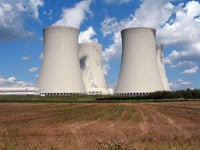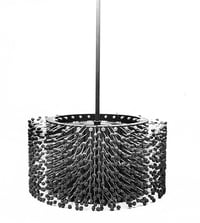 Nuclear power plants need to decontaminate large-bore water pipes in a way that’s safe, efficient, and cost-effective. Chemical decontamination shields personnel from high levels of radioactivity, but produces high volumes of radioactive chemical solutions. Mechanical decontamination removes tough layers of radioactive oxides, but can require time-consuming labor and the disposal of contaminated blasting media.
Nuclear power plants need to decontaminate large-bore water pipes in a way that’s safe, efficient, and cost-effective. Chemical decontamination shields personnel from high levels of radioactivity, but produces high volumes of radioactive chemical solutions. Mechanical decontamination removes tough layers of radioactive oxides, but can require time-consuming labor and the disposal of contaminated blasting media.
To solve this maintenance challenge, some nuclear power plants are taking a flexible approach. As Brush Research Manufacturing (BRM) explains in Today’s Energy Solutions, a magazine for the power generation industry, a commercial nuclear power plant in the central U.S. is using BRM Flex-Hone® tools to remove radioactive oxide layers from large-bore water pipes. The result is less cost, less waste, and less exposure.
From Engine Rebuilds to Nuclear Power Plants
According to Dan Stoltz, a radiation protection supervisor, the nuclear power plant had been using abrasive blasting, but wanted a better mechanical decontamination method. Stoltz knew that automotive mechanics use Flex-Hone® tools to hone engine cylinders, and this led him to contact BRM. The Los Angeles, California company analyzed the nuclear power plant’s requirements and suggested several Flex-Hone® tools.
The nuclear power plant then equipped a test facility with large-diameter water pipes that had challenging surface conditions, but that weren’t radioactive. “After we started using the flexible hone,” Stoltz says, “we knew immediately it was going to work (and) that it was exactly what we were looking for.” BRM offered some additional suggestions, and the power plant began using Flex-Hone® tools in the field.
How Flexible Honing Cut Costs, Waste, Exposure
 In the nuclear power industry, pipe decontamination is a significant expense. Before the power plant began using Flex-Hone® tools, a contractor needed a 14-hour window to perform the work. Some of these hours were dedicated to preparation and cleanup, but most were for removing the oxide layer. Once the contractor began using the Flex-Hone®, maintenance personnel could clean each pipe in just one hour.
In the nuclear power industry, pipe decontamination is a significant expense. Before the power plant began using Flex-Hone® tools, a contractor needed a 14-hour window to perform the work. Some of these hours were dedicated to preparation and cleanup, but most were for removing the oxide layer. Once the contractor began using the Flex-Hone®, maintenance personnel could clean each pipe in just one hour.
Flexible honing also reduced the amount of radioactive waste that’s produced during nuclear pipe maintenance. Unlike other mechanical decontamination methods, the only abrasive that flexible honing uses is part of the Flex-Hone® tool itself. In addition to lowering disposal costs, less radioactive waste means less human exposure to these substances during cleanup.
Cylinder Honing and Regulatory Compliance
BRM Flex-Hone® tools also helped the nuclear power plant meet several regulatory requirements. In the United States, the Nuclear Regulatory Commission (NRC) defines the minimum wall thickness for nuclear pipes. Because the Flex-Hone® tool removes only a small amount of metal from a cylinder's walls, expensive and time-consuming pipe replacements could be minimized.
NRC regulations also require nuclear power plants to follow procedures for man-hours of radioactivity environmental monitoring (MREM). “The flexible honing method,” Stoltz said, “reduced dose rates from about 700 MREM per hour down to approximately 100 MREM.” Because personnel could work safely for longer amounts of time, fewer decontamination personnel were needed for pipe maintenance tasks.
Learn More about Flexible Cylinder Hones
BRM Flex-Hone® tools are available for any type or size of cylinder, and are the surface finishing tool of choice for applications ranging from automotive engines to nuclear pipes. Would you like to learn more about flexible honing? Then download the Flex-Hone Resource Guide today.









